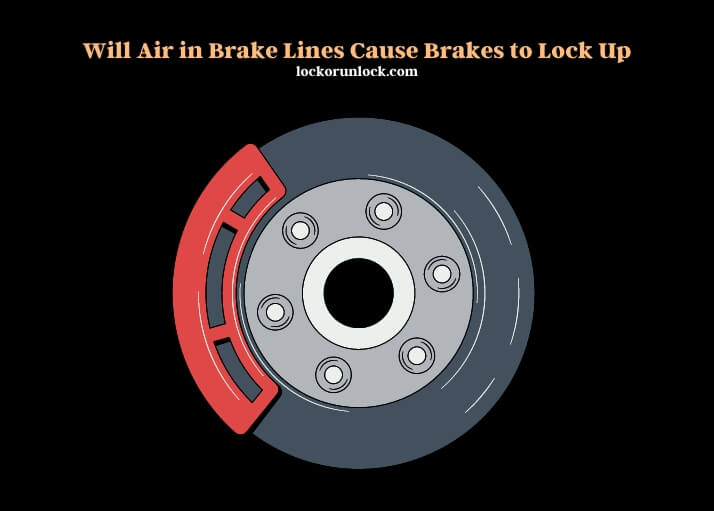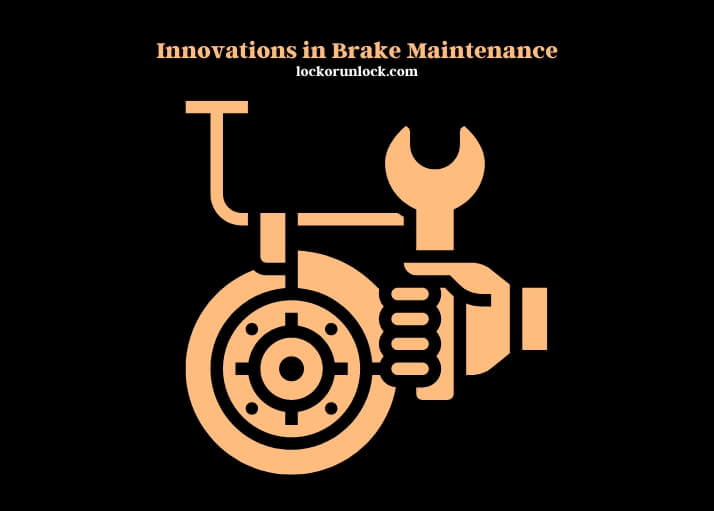Air in brake lines does not directly cause brakes to lock up. Instead, it can lead to a decrease in braking efficiency and a spongy brake pedal feel.
Air within the brake system is a significant concern for vehicle safety and performance. The presence of air disrupts the hydraulic pressure needed for brakes to function correctly. In a well-maintained brake system, the fluid is incompressible, allowing for immediate and consistent force from the brake pedal to the brake pads.
Air bubbles introduce compressibility, which absorbs some of the force applied to the brake pedal, leading to delayed braking response and increased stopping distances. This condition can compromise the driver’s ability to respond quickly in emergency situations, potentially leading to accidents. Regular maintenance, including bleeding the brakes to remove any trapped air, is essential for ensuring the braking system operates as intended.
This process restores the direct pressure needed to engage the brakes effectively, maintaining the vehicle’s safety and the driver’s confidence in their braking system. Properly maintained brakes are crucial for optimal driving performance, highlighting the importance of addressing any signs of air in the brake lines promptly.

Air’s Impact on Brake Safety
Air in the brake lines can significantly compromise vehicle safety. This occurs because air bubbles within the hydraulic system reduce the system’s ability to transmit force. When a driver presses the brake pedal, the force is not fully transferred to the brake pads or shoes due to the compressibility of air, leading to increased stopping distances and delayed reaction times.
This situation contrasts sharply with a properly bled brake system, where the hydraulic fluid, being incompressible, ensures immediate and consistent brake force application. Regular maintenance and prompt air removal are essential to prevent these safety risks.
Removing Air from Brake Lines
The process of bleeding brakes is critical for removing air from the brake lines, ensuring the braking system operates efficiently. This procedure involves several steps: preparing the vehicle, accessing the brake bleeder valves, and using specific tools to flush the brakes until all air is expelled.
Signs that air has been successfully removed include a firm brake pedal, improved brake response, and the absence of air bubbles in the fluid being expelled. This maintenance task requires precision and understanding of the brake system’s workings to be performed correctly.
Maintenance’s Role in Brake Performance
Regular maintenance plays a pivotal role in preventing brake lock-up and ensuring optimal brake performance. A well-maintained brake system is less likely to experience the introduction of air into the brake lines.
Maintenance activities should include regular inspections by professionals, DIY checks, and adherence to a maintenance schedule that emphasizes the importance of brake fluid quality. High-quality brake fluid absorbs less moisture, which can lead to air bubble formation when the fluid heats up during braking.
Consequences of Brake System Neglect
Neglecting brake system maintenance can lead to severe consequences, including increased risk of accidents due to brake failure. Case studies and accident statistics highlight the dangers of neglected brake systems, showing a clear correlation between poor maintenance and increased stopping distances, as well as higher instances of brake-related accidents. Long-term neglect can also cause irreversible damage to brake components, necessitating expensive repairs or replacements.
Innovations in Brake Maintenance
The field of brake system maintenance has seen significant advancements in tools and technologies. Automated bleeding devices and advanced brake fluids are among the innovations that have made brake maintenance more effective and less time-consuming. These solutions not only improve the efficiency of maintenance procedures but also enhance the overall safety and reliability of the braking system.

Brake Performance Comparison
| Condition | Stopping Distance | Reaction Time |
| With Air in Lines | Increased | Delayed |
| Without Air in Lines | Optimal | Immediate |
Impact of Maintenance on Brake Health
| Maintenance Activity | Frequency | Impact on Brake Health |
| Brake Fluid Change | Every 2 years | Crucial for moisture removal |
| Brake System Inspection | Bi-annual | Identifies early issues |
FAQs
Can Air in Brake Lines Reduce Braking Efficiency?
Air within the brake lines significantly diminishes braking efficiency. This inefficiency arises because air, unlike brake fluid, is compressible. When the brake pedal is pressed, the force exerted must compress the air before it can effectively move the brake fluid to engage the brake pads or shoes.
This additional step results in a spongy brake pedal feel and a noticeable delay in brake engagement, requiring longer distances to stop the vehicle safely. Regularly bleeding the brakes to remove any air ensures the braking system responds promptly and effectively, maintaining optimal vehicle safety.
Could Air in Brake Lines and Furnace Lock Out Have Similar Causes?
Air in brake lines and furnace lockout causes can have similar root issues. Both can be caused by a lack of proper maintenance, such as not bleeding the brakes or neglecting furnace maintenance. It’s important to address these causes to ensure the safety and efficiency of both systems.
What Signs Indicate Air in the Brake System?
Several signs can indicate the presence of air in the brake system. A spongy or soft brake pedal is a primary indicator, suggesting that the brake fluid is not being compressed efficiently due to air pockets.
Inconsistent braking performance or the brake pedal needing to be pressed further than usual to achieve the same braking effect are telltale signs. In severe cases, the vehicle may even pull to one side during braking if the air is unevenly distributed across the brake lines. Identifying and addressing these symptoms early can prevent potential brake failure and ensure driving safety.
How Does Air Enter the Brake Lines?
Air can enter the brake lines through various means, often during maintenance activities such as brake fluid replacement or when repairs are made to the brake system components. If the system is not properly bled to remove all air after these procedures, air pockets can remain.
A leak in the brake system can allow air to seep in, especially if the fluid level drops significantly, exposing parts of the system to air. Regular inspections and maintenance are crucial to identify and rectify any leaks or issues that could lead to air entering the brake lines.
Is It Possible to Prevent Air from Entering Brake Lines?
Preventing air from entering the brake lines involves regular maintenance and careful attention during any brake system service. Ensuring that all connections are secure and that the brake fluid is replaced and bled according to the manufacturer’s recommendations are key steps. Using the correct type of brake fluid and keeping the system sealed and clean during any repair or maintenance activity also minimizes the risk of air ingress.
Periodic checks for leaks or damage to the brake lines can help identify potential issues before they lead to air entering the system.
What Are the Risks of Driving with Air in the Brake Lines?
Driving with air in the brake lines poses significant risks. The primary concern is the reduced ability to brake effectively, which can lead to increased stopping distances and the potential for not being able to stop in time to avoid an accident. Inconsistent braking power and the possibility of the brakes failing entirely in a critical moment further elevate the danger. Regular maintenance and immediate attention to any signs of air in the brake lines are essential to mitigate these risks and ensure the vehicle remains safe to drive.
How Often Should Brake Lines Be Bled?
The frequency at which brake lines should be bled depends on the vehicle’s usage and the manufacturer’s recommendations. As a general guideline, it is advisable to bleed the brake lines during every brake pad replacement or at least every two years. Vehicles subjected to harsh driving conditions or used in high-performance settings may require more frequent bleeding to maintain optimal brake performance. Consistently monitoring the brake system’s performance and addressing any issues promptly can prevent the negative effects of air in the brake lines, ensuring the braking system remains efficient and reliable.
Summary
The presence of air in brake lines poses a significant risk to vehicle safety, affecting the braking system’s efficiency and reliability. Through regular maintenance, including proper bleeding techniques and adherence to a maintenance schedule, these risks can be mitigated. Advances in brake maintenance technology further support the importance of keeping brake systems free of air to ensure optimal performance and safety.
